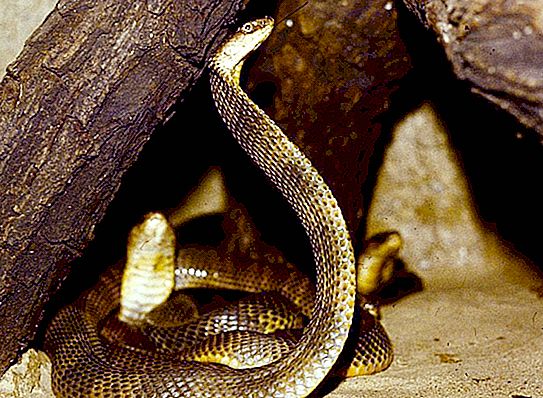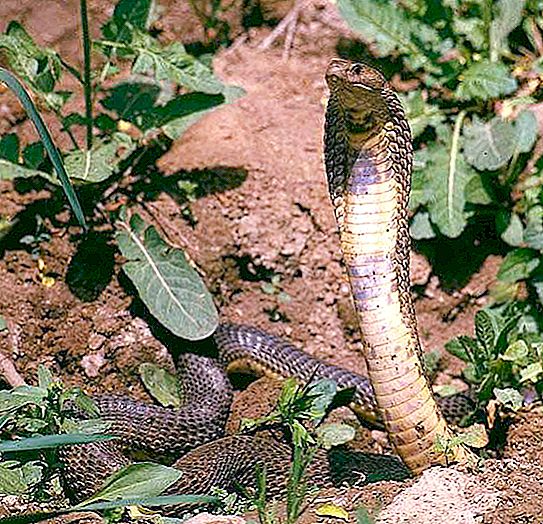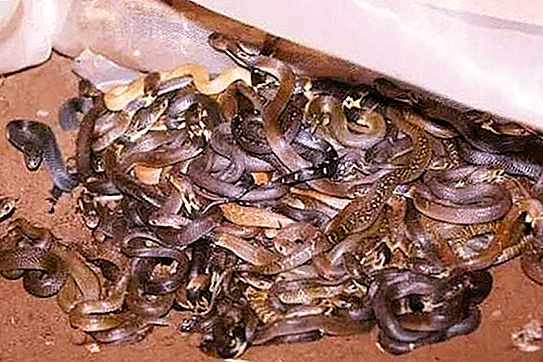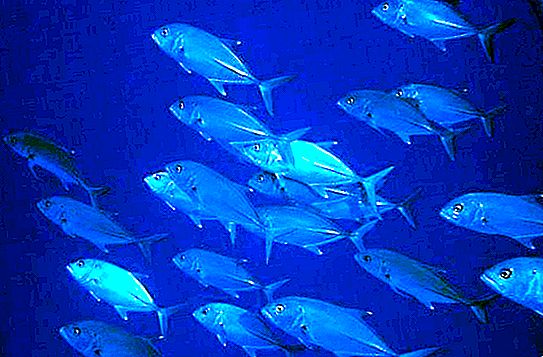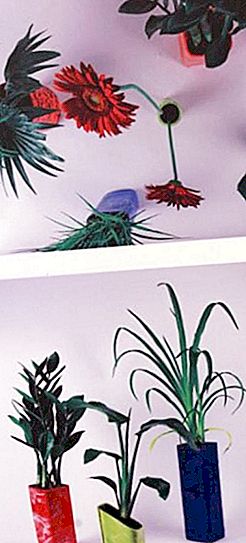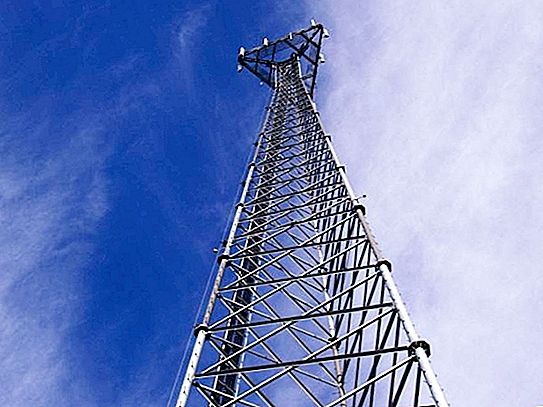A fairly large poisonous snake belonging to the family of aspids is the Central Asian cobra. This is the only species of cobras on the territory of our country with a declining population, included in the Red Book of the USSR and IUCN. There is a misconception that this snake is aggressive - in fact, it never attacks a person first.
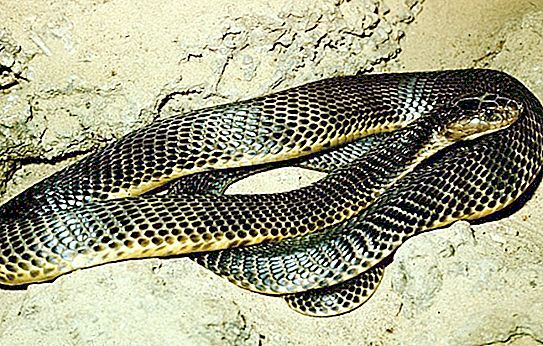
Description of Central Asian cobra
In the territories where this species of reptiles lives, populations are not numerous. Even in the most comfortable places to live (for cobras), in the warm season, it is hardly possible to meet more than two or three individuals per day. The average population density of the species is not more than 3-5 per one square kilometer. The body length of these snakes does not exceed 1.8 meters. It is covered with smooth scales, numbering from 19 to 21 rows. It is not expanded on the ridge; there are no apical fossae. There are two, less often three postorbital flaps, as well as one preorbital. There can be from 57 to 73 pairs of under-caudal flaps, and ventral - from 194 to 206.
The upper side of the body can have a different color - from light brown and olive to almost black. The belly is always yellowish. Young individuals can be distinguished by contrasting annular coloration. Their black stripes smoothly transition to the abdomen. With age, the main tone of the color darkens, and the transverse stripes expand and fade, disappearing on the belly. They are replaced by spots and specks.
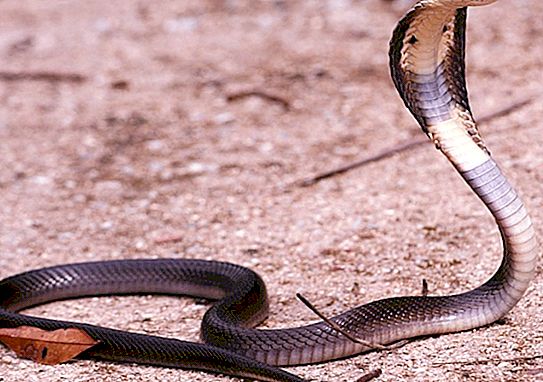
Head of a Central Asian cobra of medium size. The body of the snake smoothly passes into a tapering tail. The pupils are round. The main difference from the Indian cobra is the lack of a typical pattern on the hood in the form of glasses. You need to know that the demonstrative threatening defensive posture of this snake is an innate behavioral instinct, and even snakes, barely hatching from eggs, in any danger raise the upper body and freeze in this position.
Habitat and habitat
Now let's figure out where the Central Asian cobra lives. It is quite widespread in the north-west of India, in Pakistan, Kyrgyzstan, Afghanistan, in the north-east of Iran, it is less common in the north of Uzbekistan right up to the Bel-Tau-Ata mountains, in the south-western regions of Turkmenistan and Tajikistan.
The snake prefers to settle on the slopes of the mountains, in dense shrubs among stones, on clay and crushed foothills, in river valleys. In the mountains, the Central Asian cobra, whose photo we posted in this material, can be found at an altitude of up to two thousand meters. Often she chooses abandoned buildings. You can find this species of cobras in gardens, on irrigated lands, along the edges of fields, along irrigation ditches. They creep into sandy, waterless deserts, where they stay near colonies of gerbils on the slopes of dunes.
The lifestyle of Central Asian cobra is characterized by specific daily activity: in autumn and spring it is more active in the afternoon, in summer it is active in the evening, at night and in the early morning. In the warm season, the cobra settles in the burrows of various rodents near ponds, in thickets of blackberries and ephedra, in deep cracks in the soil, niches and ravines under stones.
For wintering, Central Asian cobras prefer to settle in more solid shelters. As a rule, these are deep cracks, which are often located under residential buildings, burrows of gerbils. Wintering of this species lasts about six months. It begins in late September and continues until the end of March or April. Cobras molt twice a year - in spring and autumn.
Protective behavior
The disturbed snake assumes a characteristic pose - it raises the front of the body 1/3 of the total length, spreads the hood and hisses quite loudly. This is the protective behavior of the Central Asian cobra, which should not be regarded as aggression. It is inherent even to very young snakes.
If the person or animal that disturbed the cobra does not respond to the warning, the cobra of this species, unlike its relatives, does not make a throw to defeat, but tries to scare off the aggressor by inflicting a fake bite on him. To do this, the snake throws the front of the body forward and hits the enemy head hard. In this case, her mouth is closed. Thus, it protects poisonous teeth from injury.
Cobra venom
The poison of this type of cobra is extremely toxic - it destroys blood. This is a complex mixture of proteins with specific biological properties, toxic polypeptides and enzymes. The poison of the Central Asian cobra causes a serious pathological reaction of the body. It affects important organs and systems: the cardiovascular and endocrine, peripheral and central nervous systems, liver and kidneys, blood and hemopoietic organs.
When bitten, the poison has a powerful neurotoxic effect. The victim becomes lethargic after a bite, but soon her body begins to shake violent convulsions. It becomes superficial and breathing quickens. A fatal outcome caused by paralysis of the respiratory tract occurs after some time.
If a large dose of the poison enters the bloodstream, which occurs when the bite falls on a site near large vessels, hemodynamic shock develops. Tumors, hematomas, and other local manifestations with the bite of this cobra never arise.
The peculiar manner of biting this snake. Vipers, for example, give an instant injection with long and very sharp teeth and immediately throw their heads back. The cobra, whose teeth are much shorter, does not expect a lightning injection. She digs into the victim and does not lean back after being bitten. At the same time, the snake compresses the jaws on the victim’s body several times with effort and as if picks them over so that its poisonous teeth must be pierced, and the necessary amount of the strongest poison was injected into the prey.
Use of poison
Cobra venom is used for the production of snake serums. To study acetylcholine receptors, neurotoxins are used. Anticomplementary factors in scientific research are used as immunosuppressants.
Enzyme poison of this type of cobra are used in biochemical experiments. In addition, medicines are made from it - painkillers and sedatives, which are used for diseases of the heart and blood vessels.
Assistance to the victim after a bite
When a Central Asian cobra bites, the victim urgently needs first aid - introduce multivalent anti-snake serum or Antikobra serum. It is recommended to use anticholinesterase drugs in combination with atropine, corticosteroids, antihypoxants. For severe respiratory distress, mechanical ventilation is required.
Enemies of cobra
Despite the fact that this species is very dangerous, the Central Asian cobra in nature itself has serious enemies. Larger reptiles can eat her cubs. Adult individuals are destroyed by mongooses and meerkats. It is interesting that these animals, which do not have immunity against the venom of cobras, can very deftly distract the attention of a snake with false lunges. Choosing the right moment, they inflict a fatal bite on the occipital part of the head. Faced with a mongoose or meerkat in its path, the cobra has no chance of salvation.
Central Asian cobra feeding
Quite a variety of menus of these reptiles. They enjoy birds, amphibians, rodents. It is a large number of the latter that attracts snakes to people's homes. Thus, by eating numerous pests, cobras contribute to the preservation of the crop. True, this fact does not reassure people who are trying in every possible way to get rid of such a dangerous neighbor.
The basis of the diet of most reptiles, including cobras, are amphibians. It can be frogs or toads. They will not refuse to eat smaller reptiles, such as efs, small boas, lizards, and small birds (goats and passerines). Quite often, they ruin bird clutches.
Breeding
Cobras of this species become sexually mature by three to four years. Reproduction of the Central Asian cobra has its own characteristics. Mating occurs in early spring, as a rule, this occurs in early May. Pregnancy lasts a little over two months. In early July, the female lays from 6 to 12 oblong-shaped eggs. The weight of each of them ranges from 12 to 19 grams, and their length is not more than 54 mm.
Cubs of the Central Asian cobra hatch from the end of August to the end of September. The length of the cubs is about 40 millimeters.
Breeding cobras
Interestingly, in the villages of Vietnam, peasants grow cobra at home - after receiving the cubs and growing them to a certain size, they turn them into a serpentarium. There, kids are fed with pressed sausages, which are prepared from secondary fish processing products. They add the crushed skin of toads, which is especially loved by cobras. Later, poison is obtained from them, which is used to make various medicines.
At the beginning of the eighties of the last century, about 350 representatives of Central Asian cobras were kept in zoos and serpentariums of our country. Successful incubations of egg clutches were obtained, which were obtained from females fertilized in vivo. After the Soviet Union collapsed, these works were curtailed, but today they are being restored.

